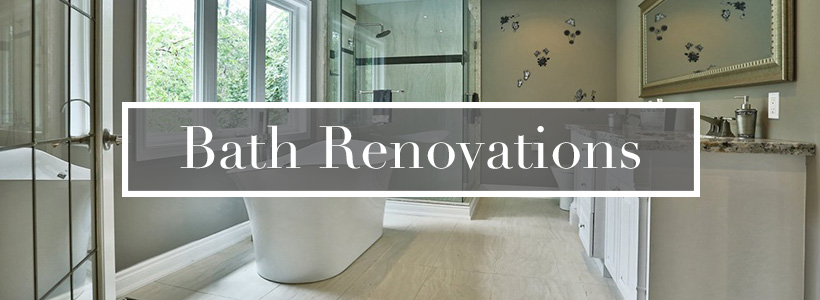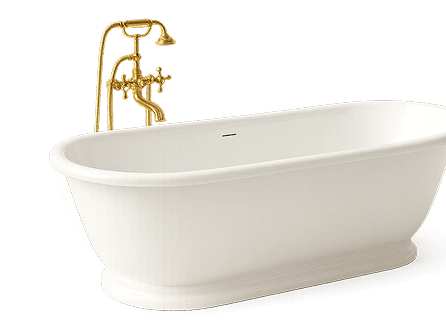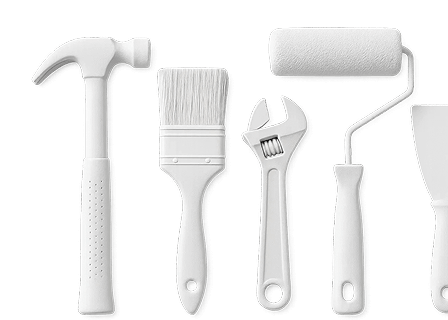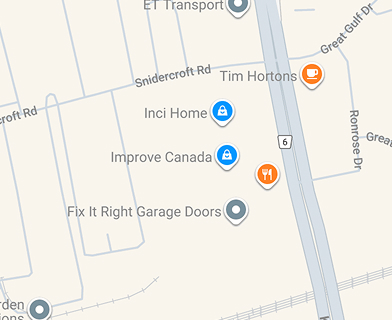
You have probably heard a lot about installing heated floors during high-end bathroom renovations, and you are thinking while you are renovating you might as well go all out right? Well, perhaps and you might even be thinking to yourself what, exactly, is a radiant heated bathroom floor? That is a great question! A radiant heated floor is one with a system installed under the floor where heat is delivered directly to the panels and heat then radiates up through the floor, which is why it is called a radiant heated floor.
So now that we know what this kind of floor is let’s figure out if it is right for you.
Pro: They provide smooth and even heat
Due to the fact that heat is provided to a series of tubes or panels under your floor it heats up gradually and evenly over the entire floor. This is the opposite of a forced air system where air is rapidly shot into the room but as soon as the temperature in one area of the room reaches the desired temperature the heating system shuts off. This leaves uneven patches of heat throughout a room. This kind of heat is smooth, even and constant.
Pro: They are recommended for bathrooms
How about that? You are renovating your bathroom and this kind of flooring is perfect for bathrooms. It is a match made in home improvement heaven. It’s great for bathrooms because this kind of system works well with tile and laminate flooring which are the materials typically used in a bathroom.
Pro: They have different kinds of heating for these floors
There are two kinds of radiant heated flooring: hydronic systems or electric radiant. The hydronic systems use tubes beneath your floor which carry hot water through them to create the heat. The initial investment for this type is usually higher, but it saves you in operation costs over time. Electric radiant floors use conducting plastic mats under your floor to transfer current and heat your floors. Electric radiant floors work just as well as hydronic but they are usually too expensive, operationally, to install and run in more than one small room.
Con: Some (read: All) Assembly Required
This is, unfortunately, not a product which is ready to use out of the box. Both types of systems require someone, particularly a contractor, who has experience with installing them. Hydronic systems as much more complicated than electric radiant ones but either way if you decide to install one of these floors you definitely benefit from hiring someone to tackle it for you.
Con: Potential Floor Damage
If something goes wrong with either kind of system it might damage you flooring or, worse yet, it may require your floor to be ripped up to repair the issue. There might not be anything go wrong with your new floor but just keep in mind that should something go wrong fixing it is a large job where you will most likely need another contractor.
Con: Cost
These systems are expensive! If you are looking at an electric radiation system you should budget about $2,000 or more, however if you like the idea of a hydronic system allow for at least $10,000 but probably closer to $15,000. There is also the cost of installation and a contingency should something go wrong, but do not forget about hiring the contract to install this system: that price is for materials alone.
Overall, a heated floor in your bathroom makes a great addition and it will provide a cozy feeling to your feet first thing in the morning and it will also prove to be a great selling feature should you choose to sell your home in the future. It is time consuming and expensive to install, but it will definitely save you operational costs in the long term by allowing you to turn down other heating sources when the floors are turned on.
Radiant Heated Bathroom Floor vs. Forced Air Systems
In the battle between radiant heated bathroom floors and forced air systems, the choice often comes down to comfort and efficiency. Radiant floor heating provides a consistent, evenly heated room, eliminating the cold spots that forced air systems can leave behind. Unlike forced air systems that rely on vents and blowers, radiant heat systems warm your space from the ground up, using heating elements or cables under the flooring. This method is more energy efficient, reducing energy bills, especially for entire homes. Plus, it offers cozy comfort without the noise and dust associated with forced air systems.
How Radiant Heating Can Reduce Your Energy Bills
Radiant heating systems aren’t just about comfort; they can significantly reduce energy bills. By warming your bathroom floor directly, these systems operate more efficiently than forced air systems, which often waste energy heating the air. For instance, a radiant floor heating system can reduce energy consumption by 15-20% per square foot compared to traditional heating methods. Electric radiant heating spreads heat evenly across the floor, eliminating cold spots and reducing the need for higher thermostat settings. Over time, the cost savings from these energy-efficient systems can be substantial.
Why Choose Radiant Floor Heating for Your Bathroom
A bathroom with radiant floor heating feels completely different than one with traditional air heating systems. When heated floors radiate warmth evenly across the room, stepping out of the shower onto warm tiles is a luxury many homeowners cherish.
Here’s why radiant flooring is a smart choice:
- Energy efficiency: It reduces energy bills over time, unlike forced air heating.
- Consistent warmth: The room stays evenly heated, without cold spots.
- Silent operation: No noisy air heating systems.
- Low maintenance: Minimal upkeep compared to other heating systems.
- Installation flexibility: Ideal for both new and existing homes.
Installation Process of Radiant Floor Heating Systems
Starting the installation of a radiant heating system for your bathroom requires careful planning. Here’s how we do it:
- Prepare the Subfloor: Ensure the subfloor is clean, level, and insulated. This step is crucial for preventing heat loss and maximizing efficiency.
- Lay the Heating Elements: Install heating cables or mats according to the layout. Make sure to avoid overlapping to maintain even heat distribution.
- Connect to the Power Source: Safely connect the heating system to the electrical panel or boiler system. This may involve specialized wiring.
- Install the Flooring: Carefully place the tiles or other flooring materials over the heating system, ensuring no damage to the heating elements.
- Test the System: Once installed, the system is tested for functionality and adjusted to provide optimal room warmth.
Need help? Contact our professional radiant heating installers during your bathroom renovation to ensure your system is set up flawlessly. With the right expertise, you’ll enjoy the full benefits of evenly heated floors and maximum energy savings. Proper installation is key to avoiding potential issues and ensuring long-term comfort in your home.
Additional Articles about Bathroom Renovation:
- 4 Ways to Transform Your Basement
- 5 Tips to Turn Your Bathroom into a Home Spa
- 5 Ways to Create a Senior-Friendly Bathroom
- 6 Benefits of a Written Kitchen Renovations Contract
- 6 Must-Know Requirements when doing Kitchen Renovations Aurora
- 7 Reasons to Consider Winter Kitchen Renovations Milton
- A General Overview of the Home Renovation Process
- A Guide to Permits Required for Kitchen Renovations Nobleton
- About
- Bathroom Fixtures: Choosing the Right Ones
- Bathroom Mildew: How to Deal with It
- Bathroom Mold: Causes and Prevention
- Bathroom Remodel: Is There a Warranty?
- Bathroom Remodelling Do’s and Don’ts
- Bathroom Remodelling: How to Choose High-Quality Materials
- Bathroom Renovation Blog
- Bathroom Renovation Tips to Enjoy Your Experience
- Bathroom Renovation: Planning the Process
- Bathroom Renovations in Oakville, Mississauga
- Bathroom Renovations & Remodeling in Vaughan, Richmond Hill
- Bathroom Renovations Remodeling in Toronto & Etobicoke
- Bathroom Renovations: How to Get Your Perfect Space
- Bathroom Renovations: How to Get Your Perfect Space
- Bathroom Vanities in Toronto & Mississauga
- Caring for your bathroom vanity cabinet
- Choosing the perfect bathroom vanity cabinet
- Should you consider DIY or use a professional
- Choosing the perfectly sized bathroom vanity
- How to install a bathroom vanity
- Getting the most out of your bathroom vanity storage space
- Choosing the correct top for your bathroom vanity
- Caring for a wooden bathroom vanity cupboard
- Bathroom vanity cabinet design trends
- Bathroom Visualizer
- Bathtub Materials 101: Things to Know Before Your Bathroom Renovation
- Bathtubs Toronto Mississauga
- Before / After
- Benefits of Installing a Walk- In Tub
- Best Renovation Tips for your Bathroom
- Best Tips for Your Kitchen Renovation
- Blog
- Build Equity with D.I.Y. Projects
- Change Your Living Space Using Crown Molding
- Checklist Before Starting Kitchen Renovations Thornhill
- Common Wallpaper Problems and Solutions
- Consider a Custom Bathroom Renovation
- Contact
- Costs to Remodel Your Bathroom
- Edge Visualizer
- Faucets Toronto Mississauga
- Finish Carpenter Staircase Installation Tips
- Five Tips for a (Mostly) Stress-Free Bathroom Remodel
- Five Ways to Make Your Small Bathroom Seem Huge
- Frameless Shower Doors: The Benefits
- From So-So to Sanctuary: Designing the Bathroom of Your Wildest Dreams
- Future Bathroom Fixtures and Upgrades to Know About
- Great Fire Place Ideas
- Have a Small Bathroom? Tips for Remodeling It
- Have Extra Room in Your Home? Consider These Renovations!
- Having a Plan: The First Step to an Ideal Home Renovation
- Home Renovation Blog
- Home Renovation Company Toronto
- Home Renovation Improvements that Add Value in 2016
- Home Renovations & Remodeling
- Home Renovations = Win/Win for Homeowners
- Home Renovations to Tackle During a Staycation
- Hot Trends in the 2016 Housing Market
- How can you Bring Kitchen Renovations Bolton Costs Down?
- How to Choose the Perfect Bathroom Vanity
- How to Fund Your Home Remodelling Investment
- How to Remodel Your Bathroom While Sticking to a Budget
- How to Transform Your Bedroom and Kick Insomnia Out
- It Pays to Be Realistic: Your Bathroom Remodeling Plan
- It’s Your Choice: Types of Bathroom Faucets
- Jacuzzi – Whirlpool Tub in Mississauga & Toronto
- Keeping Your Bathroom Renovation Environmentally Friendly
- Kitchen & Bath Inc.
- Kitchen Cabinets Toronto
- 5 Storage Solutions for Kitchen Renovations
- All you Need to Know About Kitchen Cabinets
- DIY: Paint Kitchen Cabinets Like a Pro
- How to Get a Trendy Kitchen That Won’t Soon Be Outdated
- How to Select the Perfect Cabinet
- Important Questions to Ask When Shopping for Kitchen Cabinets
- Kitchen Cabinets: 7 Important Things to Know
- Kitchen Cabinets: You Don’t Have to Start from Scratch
- Kitchen Hardware
- Kitchen Remodelling: Cabinet Door Styles 101
- Light or Dark Kitchen Cabinets?
- Modern VS Old: Managing Contemporary Styles
- Redoing Your Kitchen Cabinets? 5 Trends to Know About
- Remodelling 101: Creating an Efficient Kitchen Space
- Shaker Cabinets: The Perfect Choice for All Kitchen Styles
- Should I Hire a Professional for My Kitchen Design?
- Simple Solutions for A Flawless Cabinet Installation
- Storage Solutions for Your Kitchen Made Simple
- The Benefits of Custom Designed Kitchen Cabinets
- Treasured Freatures: Cabinet Storage Trends in 2016
- Yes! You CAN Have Light Kitchen Cabinets and Dark Floors!
- What to Consider When Buying Kitchen Cabinets in 2020
- Kitchen Cabinets Designs: Which is Right for You
- Tips for Staining Kitchen Cabinets
- Cleaning and Caring for Kitchen Cabinets
- How to Choose Contractor for Kitchen Cabinet Installation
- Choosing Kitchen Cabinets: Stock or Custom
- Kitchen Cabinet Colour Schemes & Finishes
- Benefits of Ready to Assemble Kitchen Cabinets
- Tips for Choosing High-Quality Kitchen Cabinets in 2020
- 7 Timeless Colour Combos for your Kitchen cabinet
- 7 Ways to Maximize Storage Space in your Kitchen Cabinets
- 8 Mistakes you want to avoid while painting kitchen cabinets
- Choosing a Kitchen Cabinet Material: A Simple Guide
- Budgeting for your kitchen cabinets
- Cabinet Door Styles to spruce up your kitchen
- Painting your Kitchen cabinets
- The A2Z of Kitchen Cabinetry – Part 1
- The A2Z of Kitchen Cabinetry – Part 2
- The Complete Guide to Refacing your Kitchen Cabinets
- Care and Maintenance Tips for Your Kitchen Cabinets
- Adding More Cabinets to Your Kitchen
- Re-facing Your Tired Kitchen Cabinets
- Painting Your Kitchen Cabinets to Update the Look
- Why You Need to Update Your Kitchen Cabinets
- The Best Way to Clean Your Kitchen Cabinets
- Refreshing Your Kitchen Cabinets
- Ways to Update Your Kitchen Cabinets in 2020
- Are You Getting the Most Out of Your Kitchen Cabinet Space
- Are Your Kitchen Cabinets Making Your Kitchen Look Old and Drab
- Benefits of Choosing Custom Kitchen Cabinets
- Add 5 These Features to Your Kitchen Cabinets
- Painting Your Kitchen Cabinets Doesn’t Have to Be Hard: Tips to Help
- Learn How to Paint Your Kitchen Cabinets: The 101 Guide
- Your Kitchen Cabinet Buying Checklist
- Your Kitchen Cabinet Guide: What to Know and Look For
- Signs You Need to Replace Your Cabinets and Not Reface Them
- Beautiful Kitchen Cabinets: Door and Drawer Options
- Things to Consider When Choosing Kitchen Cabinet Pulls and Knobs
- Kitchen Renovation Blog
- Kitchen Renovation Brampton
- Kitchen Renovation Company Toronto
- Kitchen Renovations and Remodeling in Toronto
- High Quality Plywood is all the Rage in Cabinetry
- How to Avoid Cabinet Painting Mistakes
- How to Spruce Up a Tired Kitchen
- Renovating a Kitchen on a Budget
- Saving on Kitchen Renovation Costs
- Kitchen Renovation Pitfalls You Should Avoid
- The Complete Kitchen Renovation Checklist
- Planning your Kitchen Workflow
- Five Timeless Kitchen Renovation Ideas
- Dos and Don’ts for Kitchen Renovation
- 5 Budget Friendly Kitchen Renovation Ideas for Improved ROI
- Budgeting for your Kitchen Remodel
- Five Kitchen Trends that will define design in 2016
- Selecting the right backsplash
- To repair or replace the countertop during kitchen renovation
- Kitchen Renovations Company Oakville
- Big Ideas for Small Kitchen Spaces
- Dark Kitchen Inspiration
- Designing Your Contemporary Kitchen
- French Kitchens
- Gold Kitchen Ideas
- Investment Potential in Renovating your Kitchen
- Kitchen Floors
- Kitchen Lighting Ideas
- Kitchen Renovation Costs
- Kitchen Renovation Design Trends for the New Year
- Kitchen Renovation Ideas – 2020 Edition
- Kitchen Renovation Warranty
- Selecting Countertops for Kitchen Renovation
- Simple Guide to Kitchen Renovation
- Top Four Kitchen Ideas for the New Year
- Top Kitchen Accessories
- What We Love and Hate about White Kitchens
- Kitchen Renovations In Burlington
- Kitchen Renovations In Etobicoke
- Kitchen Renovations Vaughan, Richmond Hill
- Kitchen Visualizer
- Kitchen&Bath Blog
- Kitchen&Bath Renovation Guide
- Kitchen&Bath Specials Finder
- Kitchen&Bath Specials Finder PPC
- Latest Trends in the Bathroom Tile You Might Want To Check Out
- Master Bath Suite: You Need One
- Milton Kitchen Renovations & Remodeling
- Modern Kitchens
- Oakville and Mississauga Home Renovations
- 4 Tips To Make Bathroom Renovations Successful
- 5 Common Mistakes To Avoid When Remodeling Your Home
- 5 Kitchen Remodeling Trends In 2020 That Are Here To Stay
- 5 Steps To Renovate During The Winter
- Basement Flooding: How To Avoid It And What To Do When It Happens
- Basement Remodeling Ideas To Create An Entertaining Space
- How To Make Your Home The Perfect Space For Entertaining
- Ideas For Optimal Home Lighting
- Tips For Choosing The Perfect Kitchen Backsplash
- Tips On Choosing The Best Kitchen Sink And Faucet
- Tips On Finding The Perfect Paint Colour
- Top 5 Best Flooring Materials For Bathrooms
- Top Remodeling Trends For Fall Season
- Other Renovations
- Plan for Your Bathroom Remodel! Seriously, Plan for It
- Planning a Bathroom Renovation? Avoid These Common Mistakes
- Planning for the Perfect Renovation
- Practical tips to Design your own Home Theater
- Practical Tips to Transform your Patio or Sunroom
- Privacy Policy
- Projects
- Redesigning Your Small Bathroom Space: Ideas to Consider
- References
- Remodelling Your Oakville/Mississauga Home? 5 Reasons to Install a Guest Bathroom
- Renovating Your Bathroom? 5 Tips for Choosing the Right Bathtub
- Renovating Your Toronto Home in 2020? Here Are A Few Tips!
- Renovation Special
- Renovation Summer Special
- Service
- Shower Column Toronto & Mississauga
- Small Bathroom? We Can Solve This Common Problem
- Small Spaces 101: What to Do with a Small Bathroom
- So You’ve Decided to Renovate Your Bathroom
- Stacked Stone Visualizer
- Strategies and Guidelines for Home Renovations
- Summer Deals
- Summer Deals Confirmation
- Summer Renovations Promo
- Thank you
- Thank you – Promotion Page
- Thank you global
- Thank you Renovating Helper
- The 411 on Bathroom Tile
- The Bathroom Renovation Trend You Shouldn’t Miss
- The Bathtub Conundrum: Keep It or Lose It?
- The Most Common Questions Regarding Home Renovations
- The True Cost of Remodeling Your Bathroom: Tile
- Things to Know about Renovating Your Kitchen
- Time to Renovate! Bathroom Renovation Ideas for Any Home
- Tips for Choosing Bathroom Countertops
- Tips to Lower the Cost of Your Bathroom Renovation
- Tips to Revamp Your Family Room
- Toilets Toronto & Mississauga
- Top 4 Hacks to Create More Space in Small Living Areas
- Top Mistakes Commonly Made with Home Renovations
- Toronto Bathroom Renovations & Remodeling
- Toronto Home Renovations
- Toronto Kitchen Renovations & Remodeling
- Transitional Kitchens
- Vaughan & Richmond Hill Home Renovations
- 5 Simple And Practical Home Renovations If Your Budget Is Limited
- 7 Tips To Renovate Your Home In Spring
- Avoid The Temptation Of DIY Kitchen And Bath Renovations
- Good Reasons To Invest In New Flooring
- How Do I Choose The Perfect Bathroom Tile?
- How To Budget For Your Next Home Renovation Project
- How To Design Your Ideal Bathroom Renovation With Ease
- How To Remodel Your Bathroom For The Spring Season
- How To Transform Your Bathroom Into An At-Home Spa
- Ideas And Tips For Choosing A Bathroom Faucet
- Remodeling Ideas For Your Main Floor
- Tips To Declutter On Your Next Home Renovation
- Tips To Renovate Before Selling Your Home
- Tips To Upgrade To A Master-Chef Kitchen
- What is Covered in a Good Kitchen Renovations Burlington Contract?
- What to Think About When Choosing a New Bathtub
- WholeSale
- Working through your Kitchen Renovation
- Top Bathroom Design Trends for 2016
- Bathroom Renovation Mistakes to Avoid
- The Great Debate: One or Two Bathroom Sinks
- Don’t Forget about Storage When Remodeling Your Bathroom
- What to Think About When Choosing a New Bathtub
- 12 Things to Think About Before You Renovate Your Bathroom
- How to Select the Best Paint Colour for Your Bathroom
- The Truth About Bathroom Paint
- Should I Use Wallpaper in my Bathroom?
- Walk In Shower vs Tub/Shower Combination
- Dos and Don’ts of Bathroom Renovations
- Types of Flooring for a Bathroom
- Pros and Cons of a Radiant Heated Bathroom Floor
- What to Know About Hiring a Contractor
- DIY vs Hiring a Professional
- Tips for Getting Bathroom Tile Right the First Time
- Tips for Tiling a Small Bathroom
- Ten Best Bathroom Renovation Ideas
- Should You Install a Pre-Fabricated Unit or a Tiled Shower?
- Top 10 Bathroom Accessory Trends for 2016
- Tips for Installing a New Bathroom Vanity
- Pedestal vs Vanity Sink
- Budgeting for a Bathroom Renovation
- Professional Renovation Tips from the Experts – 2020 Edition
- Trends in Bathroom Tile
- Bathroom Contractor
- Home
- Kitchen Contractor
- Kitchen Renovation Mississauga





